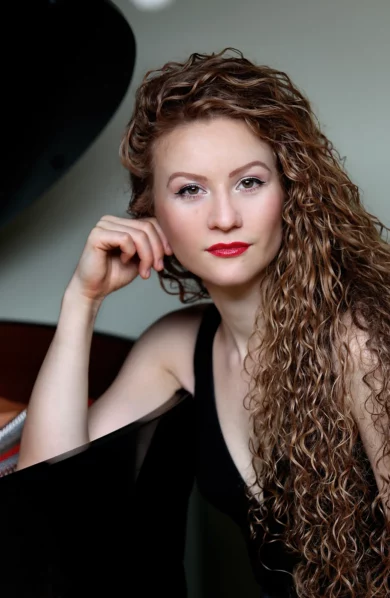Korepanova continues Rachmaninoff series with early pieces and a mature masterwork

Asiya Korepanova performed piano works of Rachmaninoff Tuesday night in Coral Gables. Photo: Emil Matveev
Friends of Chamber Music’s “Rachmaninoff at 150” series (presented in association with Abram Kreeger’s organization Piano Lovers) is proving a fascinating retrospective of the complete solo piano works of Sergei Rachmaninoff (1873-1943).
In his day, Rachmaninoff was a maverick, albeit a conservative one. While Schoenberg was abandoning tonality and a new generation of Russian composers (Stravinsky, Prokofiev, Shostakovich) were changing the sonic compass of music, Rachmaninoff remained a resolute romantic until the end of his life. Geniuses often make their own rules, and, with his inspired melodies and brilliantly imaginative keyboard writing, Rachmaninoff was nothing less than that.
Asiya Korepanova is a tremendously gifted pianist who exhibits a singular affinity for the composer’s Russian romantic idiom and possesses the blazing technique to fully realize his distinctive scores. A former student of Santiago Rodriguez (a fine Rachmaninoff interpreter in his own right) at the University of Miami’s Frost School of Music, Korepanova is an artist who deserves greater visibility and a more extensive career.
She presented the second program of this cycle Tuesday night at Coral Gables Congregational United Church of Christ, contrasting juvenilia and early works with one of Rachmaninoff’s mature masterpieces.
Korepanova opened the evening with her own matchup of a prelude and fugue. Song Without Words (a teenage piece from 1887) served as a ruminative introduction to a grandiose Fugue in D minor written in 1891. Even these early creations reveal considerable mastery of keyboard invention and Korepanova had the full measure of these works’ bravura.
Rachmaninoff’s strong command of counterpoint and polyphony were manifest in the Prelude in F Major (1891) and Fughetta in F Major (1899). More formal and closer to Baroque roots, these vignettes gave Korepanova an opportunity to demonstrate her wide palette of colors. The Morceaux de Fantaisie in G minor (1899) and Canon in E minor (1891) seem more like compositional studies but, through precision and attention to detail, Korepanova made something larger of these essays.
Korepanova concluded the concert’s first half by returning to 1887 and an aspiring teenage composer finding his voice in 4 Pieces. She produced pearly ltones from the Bösendorfer in an intense “Romance.” A stormy interlude interrupted the ornamental lines of “Prelude.” There were more than mere suggestions of the imperial Russia of Tchaikovsky in “Melodie in C Major.” A quirky, playful “Gavotte” presaged the dance movement in Prokofiev’s Classical Symphony.
Following intermission, Korepanova offered 3 Nocturnes (1877). Rachmaninoff’s definition of a nocturne was an ocean away from the delicacy of Chopin’s works in that genre. By turns brooding, bold and nationalistic, these brief pieces served as overture to the concert’s main event.
The Corelli Variations (1941) were among the handful of scores Rachmaninoff produced after moving to the West following the Soviet revolution in 1917. Based on the “La Folia” theme (falsely attributed to Corelli), this twenty-minute tour de force ranks with such works as Beethoven’s “Hammerklavier” Sonata and Balakirev’s Islamey for sheer technical difficulty and interpretive challenges. When performing the score in concert, Rachmaninoff himself would skip some of the twenty variations out of boredom or dissatisfaction with his execution.
Korepanova played the complete opus, managing to sustain a contemplative mood and structural framework across the contrasting sections. She took the famous theme at a leisurely pace and brought elegance to the Chopinesque embellishments of the first variation. Turning dreamy, rhapsodic or impulsive, she imbued each of the variants with a specific aura and voice while maintaining momentum throughout the entire set.
Her fluent articulation and contrasts of volume and tone contributed to a reading marked by authoritative depth and evenness of sonority and virtuosic agility. A repeat of the main subject emerged almost as a reverie. Korepanova brought heated abandon to the penultimate variation and a lyrical sense to the coda, for once not sounding like an anticlimax but a summation and epilogue to all that had come before it.
The audience was so attentive that one heard nary a cough nor cell phone. Korepanova responded to repeated curtain calls with a restrained, finely tinted encore of Rachmaninoff’s Elegie. This rewarding evening makes one look forward to Korepanova’s continued exploration of Rachmaninoff’s output.
Friends of Chamber Music presents pianist Stephen Hough playing Mompou’s Cants Magics, Scriabin’s Sonata No. 5, Debussy’s Estamps, Hough’s own Sonatina Nostalgica and Liszt’s 3 Petrarch Sonnets and Dante Sonata 8 p.m. March 28 at Coral Gables Congregational United Church of Christ.
“Rachmaninoff at 150” continues with Asiya Korepanova playing Rachmaninoff’s complete Etudes-Tableaux 8 p.m. May 16. miamichambermusic.org
Posted in Performances
Leave a Comment
Wed Mar 15, 2023
at 10:35 am
No Comments